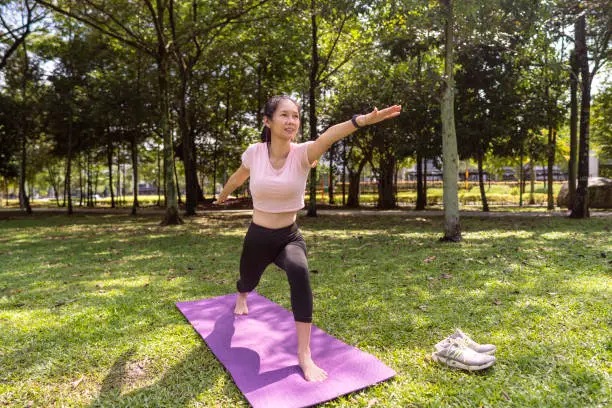Stretching is integral to a fitness routine, but it can be challenging to figure out what stretches are best for you.
Here we will look at some of the best beginners stretches for improving flexibility. Some of these stretches can also help relieve pain and stiffness in various muscles, such as your back or hips. For each stretch, we’ll give you tips on performing it correctly so that it’s effective without putting too much stress on your body!
Core stretches
The core area of your body includes the trunk, pelvis, and hips. It supports the torso and transfers force between the upper and lower limbs.
To improve flexibility in this area:
- Sit on the floor with your legs in front of you, about shoulder-width apart. Lower yourself with palms on the floor until you’re sitting on your heels with your spine long (not rounded). If a seated position is too difficult or uncomfortable at first, try doing this stretch from a standing position or lying down on your back with bent knees.
- While keeping an even distribution of weight between both feet as much as possible (feel free to shift forward slightly onto one hip if needed), reach up towards the ceiling with both arms straight overhead until there’s a slight stretch in chest muscles; hold for 20–30 seconds then repeat two times on each side
1. Cobra Pose
- Start by lying on your stomach with your arms below you, palms down, and facing forward.
- Bend your elbows to align with the shoulders, then lift the head and chest off the floor as high as possible while keeping a flat back (like a cobra ready to strike).
- Hold for 30 seconds at a time, working up to 3 minutes each session. If you feel pain in your lower back during this stretch, place a pillow under it or modify the pose by bringing just one leg straight up towards the ceiling instead of both legs up the ceiling.
- If you want more of an upper-body stretch: Raise only one arm overhead—or even just one finger!—and hold for 10 seconds before switching arms; repeat three times on each side (six times total).
2. Cat-Cow Pose
Cat-Cow Pose: This pose is a good introduction to stretching because it allows you to stretch your back, chest, and shoulders.
How To Do It:
- Start on your hands and knees in a tabletop position with wrists below shoulders, palms flat on the floor. Your knees should be hip-width apart and aligned directly under your hips. This is the same starting position for a down dog yoga pose or high plank push-ups (if you’re doing those).
- Inhale as you arch up through the spine, opening up the chest, look toward the ceiling, then exhale as you round your back, lowering your chin toward the chest and rounding into a cat shape before returning to your original position; repeat ten times for 1 set, increasing each time by 5 reps until reaching 20 repetitions per set
- Rest 30 seconds between sets if needed but aim for 3 sets in total (60 repetitions)
3. Seated side-straddle stretch
The side-straddle stretch is a simple and effective way to stretch the sides of your body. To do it, sit on the floor with one leg crossed over the other. Bend both your knees so you’re sitting in a cross-legged position, and then lean forward, hugging your left foot with both hands while letting your right leg hang behind you. Hold this pose for 15 seconds before switching sides and repeating it on the other side of your body.
If this stretch feels too challenging for you (or if you would like to add more resistance), try putting something heavy in between each hand as they are wrapped around the ankle; this will make it harder for them to let go of the ankle which will make a move more difficult!
This stretch is great because it targets all parts of our inner thighs at once, allowing better balance in our poses and overall flexibility throughout our bodies!
4. Bridge Pose
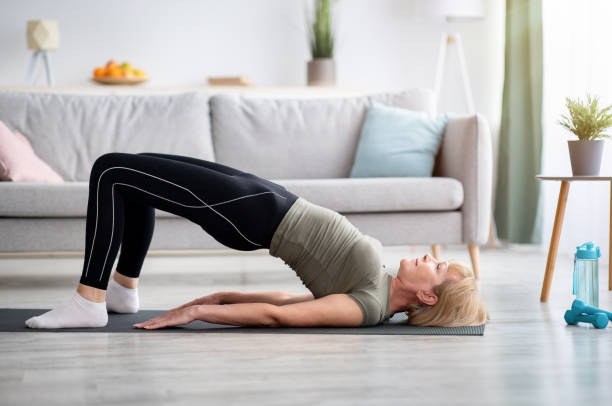
- Lie on your back with your knees bent and your feet flat on the floor.
- Lift your hips up and off the floor, using your hands to support the lower back if needed.
- Hold for 30 seconds before repeating three times
5. Swiss ball ab stretch
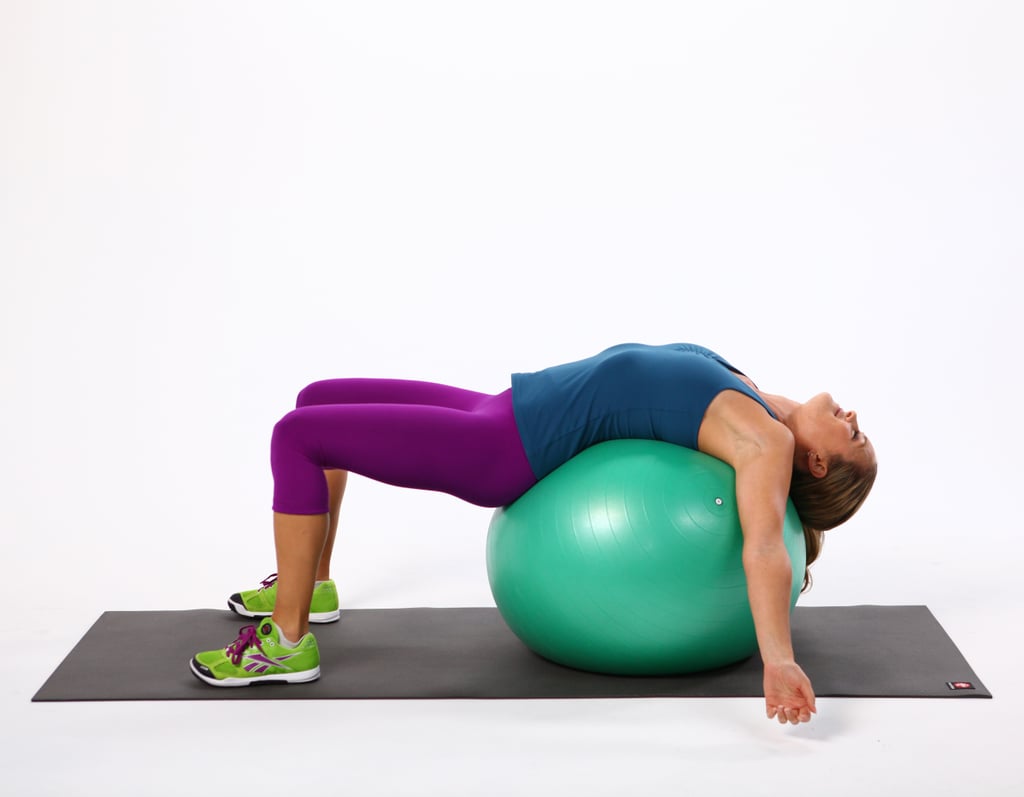
To do the Swiss ball ab stretch, place your body on the floor with your feet on the Swiss ball and arms extended in front of you. Then lift your torso off the ground until it’s parallel to it. Hold this position for 30 seconds while breathing deeply. To modify this stretch, keep one foot planted while lifting with the other leg and make sure both are lifted equally high above their respective knees (if one knee is lower than the other, that’s a sign that you need to spend more time stretching).
6. Seated inner thigh stretch
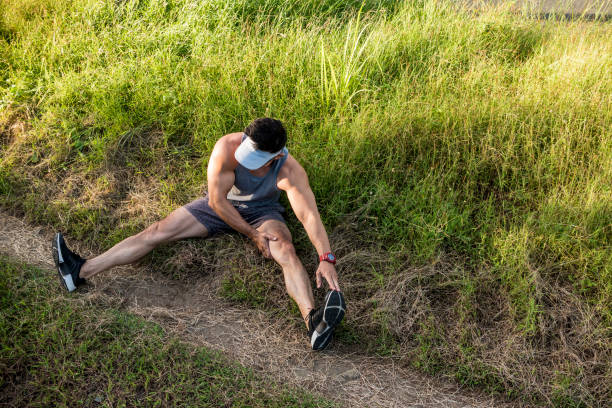
Sit on the floor with your legs outstretched in front of you. Place a towel under your hips, cross one ankle over the other and pull that foot toward your body. Hold for 30 seconds, then switch legs. Repeat three times on each side.
7. Heel drop stretch

This stretch is great for the hamstrings, calves, and Achilles tendon.
To do this stretch: Stand in front of a chair or bench. Lift one foot off the floor and bring your heel as close to your buttocks as possible. Hold this position for 30 seconds, and then repeat with your other leg.
8. Standing quad stretch
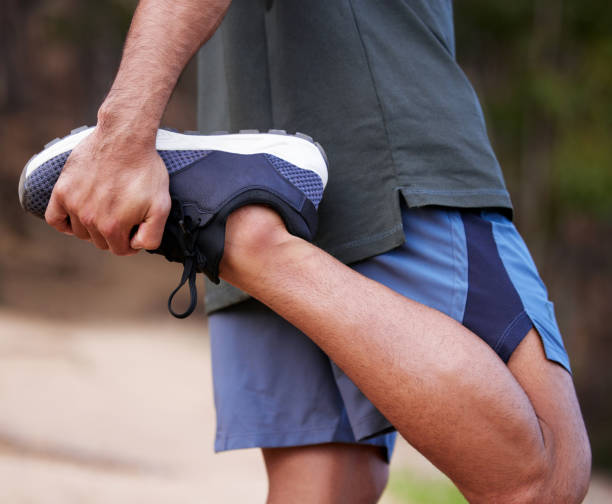
This stretch is simple and effective. Stand with your legs about two feet apart, then bend your left leg up toward the ceiling until you feel a stretch in your quad. Hold that position for thirty seconds before repeating on the other side.
9. Runner’s lunge
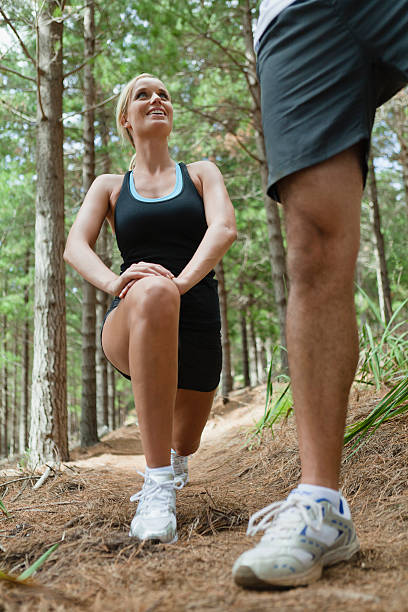
The runner’s lunge is a great stretch for runners. The muscles that run along the front of your legs are shortened when you run and jog, and this stretch lengthens them.
To do it, stand with your feet hip-width apart and then step forward with one foot so that you’re in a lunge position. Lower yourself down until both knees are bent 90 degrees—your back knee should be close to touching the ground but not resting on it—and hold for 30 seconds or longer if possible.
Modify this stretch by placing an exercise band around both ankles before making a move; this will help activate the glutes more than normal, which is important for runners who tend to have tight glutes! If you don’t have access to exercise bands, place a towel under each foot; it will still help activate those muscles even though it’s not as effective as an actual resistance band. You can also perform this pose with a partner by having him, or her gently but firmly pull on your arms from behind (this helps activate even more muscle groups).
If none of those options work well at first, try using a wall instead! Put both hands against its surface while standing tall with feet together facing away from the said wall (or right next to each other) until they feel comfortable enough going deeper into their respective stretches without losing balance – try doing ten slow breaths here before moving onto something else if necessary!
10. Reclined Pigeon Pose

- Lie down on your back, with knees bent and feet flat on the floor.
- Bring your right knee towards your chest, and wrap both hands around it for support.
- Reach the right arm towards the right foot, keeping it straight as much as possible (but don’t strain). You can use a strap or towel to help you hold this position if needed—if you’re using one and need extra assistance, try turning your head to look at that side of the room while holding this stretch so that you have something else to focus on besides just holding yourself up with just one hand!
- Hold for 30 seconds before repeating on the other side
Arm stretches
The arms are a part of the body that many people forget about when it comes to flexibility and stretching. However, arm stretches can be just as important for your overall health as any other stretch. Your arms are responsible for many everyday movements and actions, so keeping them loose and flexible is vital to avoid injury.
Arm stretches can also help with balance, posture, and stress relief. When you hold an arm stretch for at least 30 seconds (or longer if you’re capable), you will feel the muscles in your shoulders and back begin to relax while simultaneously creating space between each vertebra in the spine—which helps improve posture as well as lower stress levels by allowing oxygenated blood flow into those areas.
11. Eagle arms stretch
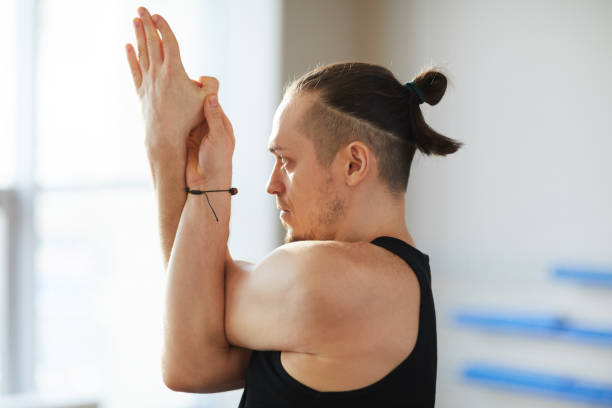
The eagle arms stretch is a great way to open up your shoulders and improve mobility. To perform it, stand with your feet hip-width apart, then raise one arm straight out in front of you while bending the other arm behind you. Turn both palms down and push forward into the stretch, keeping your core engaged throughout. Hold for 30 seconds before switching sides.
Flexibility can improve balance and stability in everyday movements like reaching for something or turning around quickly—which may help reduce injury risk! If you’re new to stretching or have tight muscles from sitting at a desk all day long, try performing this stretch every day for two weeks before moving on to more advanced stretches like this one (or see if another beginner-friendly variation works better for you).
12. Fingers up and down stretch
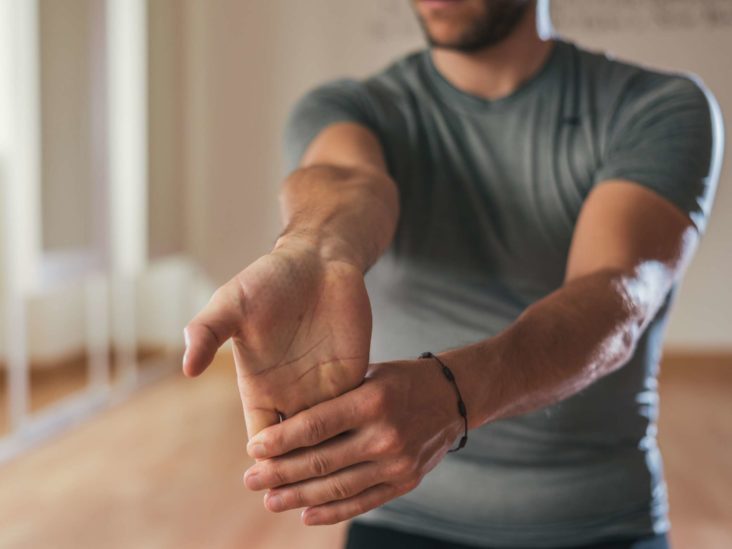
Place your hands on the back of a chair or wall, and lean forward until you feel a stretch in your shoulders. Keep your back straight, and keep your head up. Hold for 30 seconds, then repeat 3 times.
13. Overhead tricep stretch
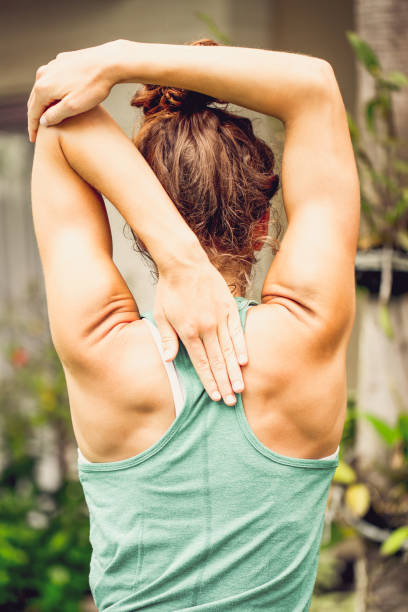
- Start by standing with your feet hip-width apart and your arms in front of you at shoulder height.
- Grab a towel or strap with both hands and hold it overhead, straightening your arms as much as possible.
- Keeping back straight, slowly lower the towel or strap until it touches the top of your head; then return to the start position. Repeat for 30 seconds on each arm, holding for no more than 15 seconds at any point during this stretch (more is not better). Repeat three times per side and alternate sides each time you make this motion—you’ll find that stretching one side will help improve flexibility on the other side!
- Before performing this movement: if you’re unsure whether you should be doing this stretch or not, consult a doctor first before attempting; if they say it’s okay, then proceed with caution because too much weight can cause injury if used incorrectly (no pain isn’t necessarily good pain). Also, avoid using this move if you have shoulder issues like rotator cuff problems or tendinitis because these muscles are already under stress due to their location. Adding more strain could make things worse instead of better!
14. Scissor stretch
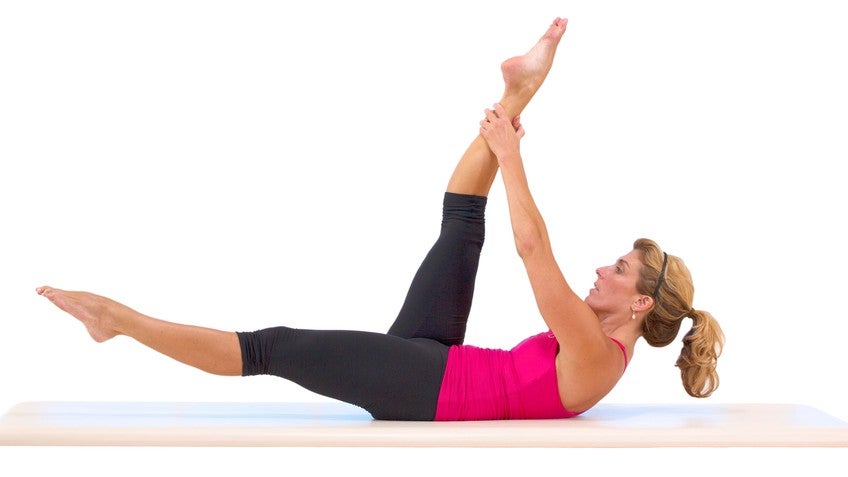
This stretch is a yoga pose that will help you improve your flexibility in many ways. It stretches the shoulders, hips, hamstrings, quadriceps, and calf muscles. It also improves your ability to balance one foot while moving the other leg behind you.
To start this exercise:
Step 1: Stand with your feet shoulder-width apart and extend both arms straight ahead at shoulder level with palms facing down toward the ground (a). Step 2: Bend forward at the waist as far as possible while keeping both knees straight until they parallel the floor (b). Step 3: Hold this position for 30 seconds or until a stretch is felt in the calf muscles. Repeat 3 times on each side.
15. Doorway pectoral stretch

The doorway pectoral stretch is a great beginner to target your chest, shoulders, and upper back. It’s also a great way to get warmed up for your workout!
Here’s how to do it:
- Stand facing away from the door with your back to the door
- Reach your arms up and over your head as far as you can (you’ll feel a slight stretch in your chest)
- Hold for 30 seconds (or until you feel a good stretch)
- Repeat 3 times
Back stretches
Back stretches are important for flexibility and maintaining a healthy back. Back stretches can be done at home or the gym. Back stretches can be done before or after a workout. Back stretches can be done with or without equipment, and they’re easy to learn!
Here are some great beginner back stretches and their benefits:
- The spinal stretch helps loosen tight muscles in your lower back, hips, hamstrings, and calves. It also relieves stress on the spine when you sit for long periods throughout the day (i.e., at work). You’ll feel more relaxed once you complete this stretch!
16. Back flexion stretch

- Lie on your back in a lunge position, with one foot in front of the other.
- Bring your arms forward and put them on the floor.
- Lean forward and try to touch your nose to your knee.
17. Knee-to-chest stretch
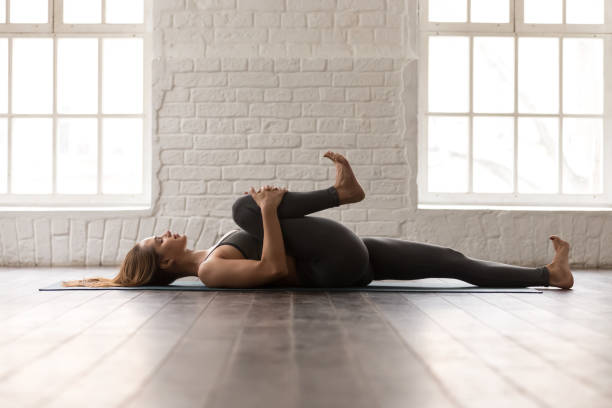
This stretch is simple but very effective for opening up your hips. Start by lying on your back with both knees bent and feet flat on the floor. Bring one knee into your chest, then use that foot to push against the other knee while bringing it toward you until they’re touching. You can also reach under and grab behind both knees if that feels more comfortable. Hold this position for 30 to 1 minute, then repeat with the other leg.
If you have any issues with your knees or lower back (like arthritis), be careful not to overstretch during this exercise so as not to aggravate any pre-existing conditions or cause new ones in those areas of concern! If this applies, make sure you take extra care when doing these exercises so as not to hurt yourself by furthering them beyond what feels good for YOU, specifically at THIS moment in time-based upon YOUR own body’s needs rather than out of obligation or social pressure from others around us who might expect us all to go through life without ever being injured unless we want something badly enough!
In addition: If someone else tells me something hurts too much – stop immediately! They are probably right because they know better than I do what their body needs now (and sometimes even better than myself).
18. Child’s Pose
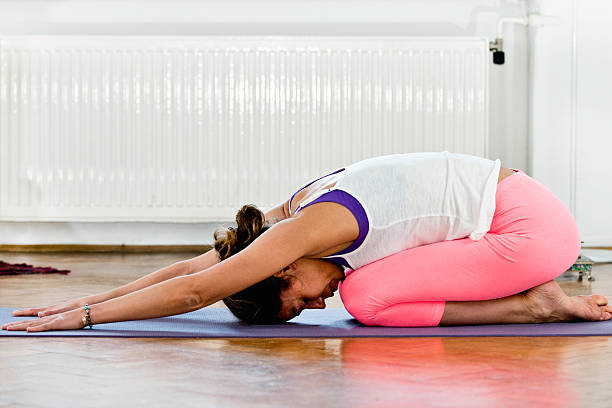
The child’s pose, Balasana, is an excellent stretch for the lower back and hips. The gentle forward bend allows you to rest your forehead on the floor (or a mat) as you extend through your knees. From here, if you’re feeling particularly flexible, you can reach your arms forward and hug them toward each other along the sides of the body. This will help open up tight shoulders while still soothing the back muscles.
You can also modify this pose by bending one knee at a time as you hinge forward from there: drop down onto one knee, then bring that foot parallel to the other before bending again at that spot until both knees are touching the ground and stretching out into a flat plank position with arms extended out in front of you as far as possible without compromising form or safety. A safer variation would be leaning over two hands instead of one with palms facing down; this gives more traction when stretching out into a full-on flat plank position with straight legs held high off the floor without having to worry about balance issues. Caused by balancing on just one hand!
19. Seated spinal twist
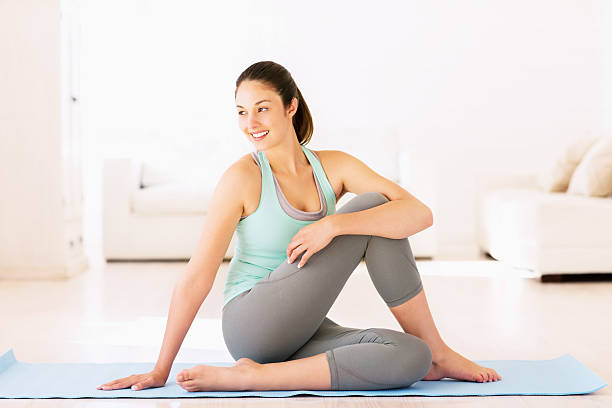
The seated spinal twist is an excellent beginner stretch because it focuses on the lower back and hips. The seated spinal twist also helps to open up your chest while simultaneously relaxing the shoulders and neck.
How to do it:
- Sit on a mat with both legs in front of you, feet together, and toes pointed forward (A).
- Bring one leg up, so your foot is near or touching your opposite knee. The other leg remains straight (B).
- Place both hands behind you on either side of your lower back, fingers pointing downward (C). Lift one shoulder blade slightly off the ground as though trying to touch it with the opposite ear (D). You should feel this movement more in your upper back than your lower back; if not, adjust accordingly until comfortable.
20. Sphinx stretch
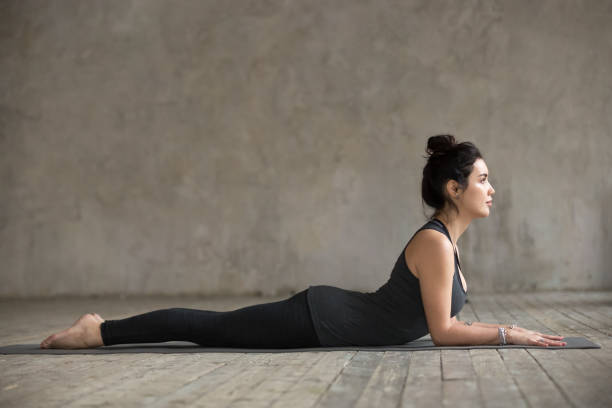
To do the Sphinx stretch, place your hands on the floor before you and walk forward until your head rests on the ground. Bring one leg up behind you, keeping it straight, and then reach back to grab hold of that foot with your hand.
Inhale as you roll to your side while bringing that bent leg towards the other arm. Reach up with one arm; exhale as you slowly lower both arms back down to the floor.
Repeat 10 times before switching sides.
Modification 1: For a more advanced version of this stretch, raise both legs off the ground at an angle to form a “V” shape rather than holding onto a single foot.
Hip stretches
- Hip stretches are great for helping to open up the hips, which can improve balance, flexibility, and mobility.
- You can do hip stretches in a chair, on the floor, or standing up.
- If you have tight hips or are trying to improve your posture and alignment, try these three easy moves below!
21. Standing hip circles

Standing hip circles:
- Stand with your feet in a wide stance; toes pointed forward or slightly outward. Your knees should be soft and relaxed, but avoid locking them out.
- Rotate your hips around clockwise as you inhale deeply through your nose; exhale slowly while continuing to move in a slow, controlled circle until you feel the stretch along the inner thighs, buttocks, and lower back on the other side of your body (this is known as a hip flexor stretch).
- After completing several circles on one side, switch legs and repeat on the other until you feel stretched out in both directions—usually, about 10 rotations total will do it!
The trick here is keeping both legs moving together so that each time one foot rotates forward into its full range of motion during inhalation/exhalation, it also returns backward into its full range of motion during inhalation/exhalation at the same time without any delay between movements (you don’t want one leg moving faster than another). Make sure not to lock out your knees or tilt your pelvis backward excessively from a neutral spine position when performing this exercise—the idea is to get some nice deep breaths by stretching muscles instead, so keep shoulders relaxed away from ears while rotating hips gently upwards toward the ceiling if possible but don’t arch back too much because then they’ll get tight too quickly!
22. Reclining Angle Bound Pose
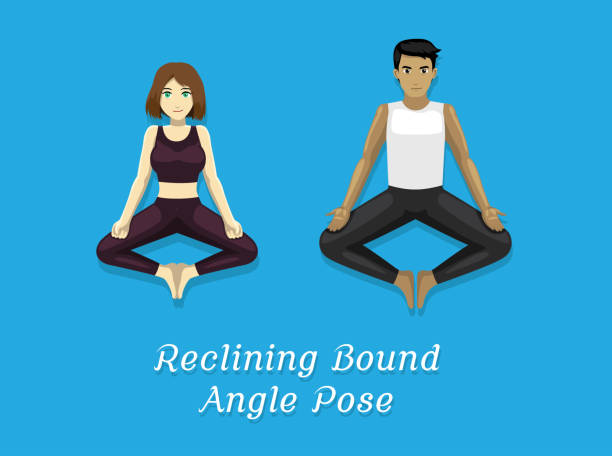
- Sit on the floor with your legs bent in front of you and feet together, knees out to the side.
- Cross one ankle over the other and bend your knees so that your feet are resting flat on the floor in front of you.
- Use your arms to pull your chest closer to your thighs as far down as possible while keeping good alignment in both shoulders (they should be above or below parallel). Hold for 30 seconds, then repeat on the opposite side if desired!
23. Lunging hip flexor stretch
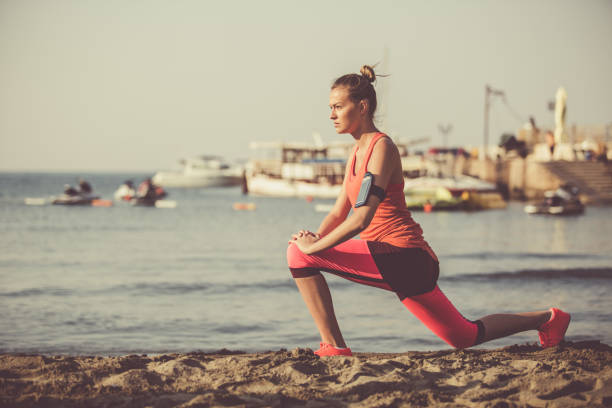
To do this stretch, simply:
- Stand with your feet hip-width apart and hold onto something sturdy for balance.
- With one leg forward, bend the other knee and lean forward with a flat back until you feel the tension in your front thigh. Do not allow your back foot to lift off the floor.
- Hold for 30 seconds or as long as possible without pain or discomfort. Then repeat on the opposite side.
24. Garland Pose
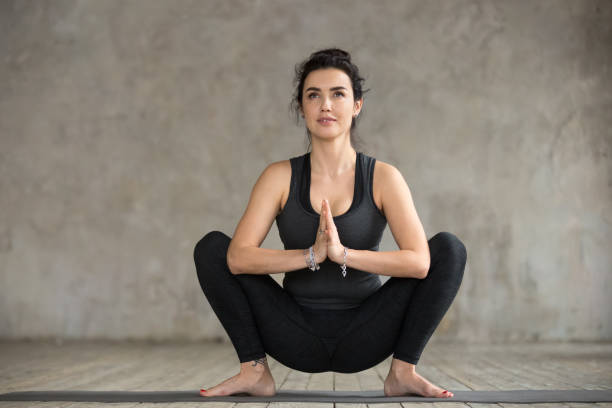
This hip-opening pose is a gentle way to stretch your hips and groins, especially if you have back pain or tight muscles around the hip joint.
The pose is named after garland flowers because it opens up the hips like blossoms on a flower stem. If you have knee pain as well (such as runner’s knee), Garland Pose can help with that too!
25. Seated IT band stretch
/FINAL_VWFitFitnessAnnotations3-5ba3f41946e0fb0057aa8cea.jpg)
Sit on the floor with your legs extended in front of you. Cross your left ankle over your right, and then bring your right knee toward your chest. Bring your right elbow to your left knee, and hold for 15-20 seconds. Repeat on another side.
Final thoughts on Best Beginner Stretches
Stretching is great for helping you to be more flexible and improve your health, but it’s important to remember that stretching should not be painful. If you feel pain when doing any of these stretches, stop them right away and consult with a doctor before starting again.









